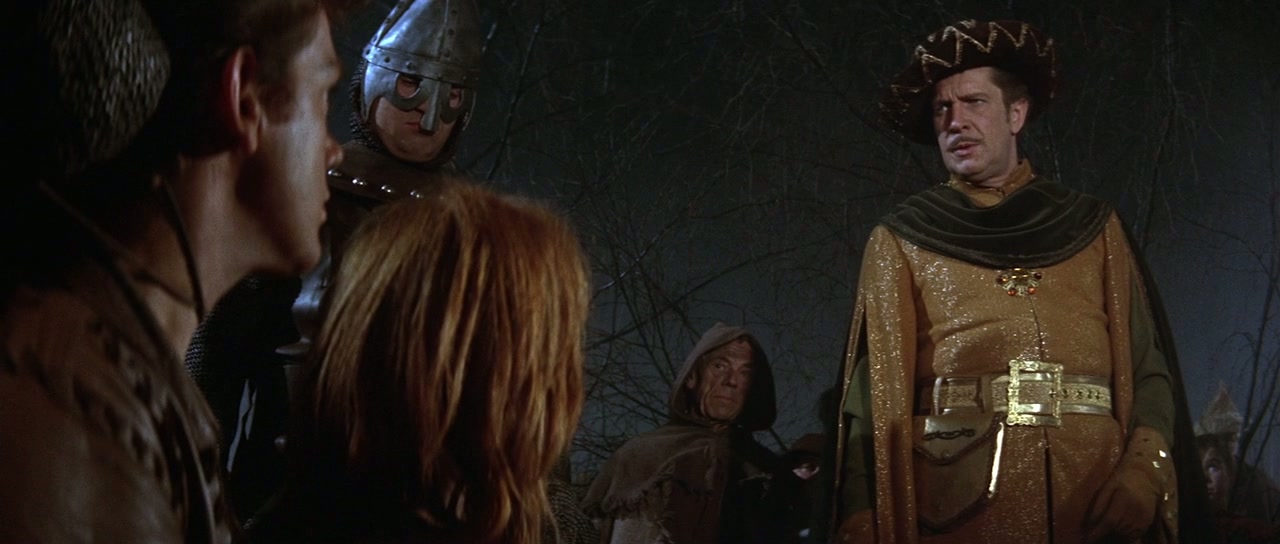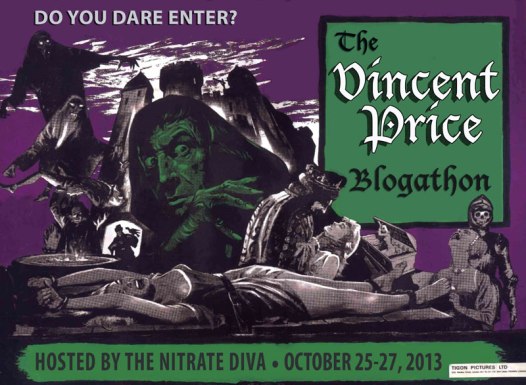The following is an entry in @NitrateDiva’s Vincent Price blog-a-thon. The Masque of the Red Death has long been one of my favorite flicks and I jumped at the chance to commit some of my love to paper, or in this case bl-g. This was my first viewing of the film in many years and my first evar! in high-def. Horror fans must pick up the new Vincent Price Blu-ray Collection from Shout!/Scream! Factory. You’ve never seen these movies look anywhere near this good. Especially Masque‘s gaudy colors and set design. But enough of all that… some newly formed (old) thoughts about Masque of the Red Death starring Vincent Price. I would have loved to dissect the film in far more detail, but the Patrick family Halloween festivities have seriously taken a toll on my psyche. (He said as the two children lay waste to the entire house while he desperately tries to finish this bl-g.)
The End is Silence: The Masque of the Red Death
Though Vincent Price made scores of movies of without Roger Corman, it is for his seven collaborations with Roger Corman on the Edgar Allan Poe adaptations that he is probably most recognized by modern audiences. Before he became the King of the Grand Guignol or the Merchant of Menace (choose your own nom de guerre), Vincent Price acted in a wide variety of films from noir to comedy. It seemed, however, from our point of view that Price was always destined to be the face of horror. His on screen presence, the intensity in his eyes… his low-pitched, rasping voice. Before his first successful starring role in Corman’s House of Usher (1960) – 22 years after his debut, Price had been predominantly a character actor with a few minor starring roles mixed in. This is a notion that’s difficult to reconcile with our conception of the legendary actor.
As we look back on his filmography, in particular the films made with Corman starting in 1960, Price became the commodity. His name eclipses the title of the movie and in many ways maintains greater relevancy than the pictures themselves. They are, perhaps to a fault, Vincent Price movies – not the Tomb of Ligeia or House of Usher or Masque of the Red Death. It is at once a measure of our worship of the Vincent Price on-screen persona and an unconscious dismissal of the unique characteristics of each film, a fact exacerbated by the workmanlike Corman/Price collaboration.

If one film, above all others, were to stand out from this era, it should be Masque of the Red Death, his penultimate Poe adaptation with Roger Corman. But it wasn’t supposed to be that way. Corman had originally pegged Masque to follow Usher, but Ingmar Bergman had released The Seventh Seal in 1957, a film that borrowed many elements from Poe’s “Masque of the Red Death.” Corman didn’t want people to suggest he’d ripped off Bergman, so he postponed Masque. While four years may not have mattered all that much in the grand scheme, the distance from The Seventh Seal served Corman well. As a self-proclaimed devourer of all films and a fervent fan of Bergman, Corman allowed himself time to digest Bergman’s film. Bergman’s influence runs rampant through Masque, elevating Corman’s directorial style and turning Masque’s meditation on Poe’s themes of morality and mortality into something greater, more visually striking and abstract than what might have come before.

Vincent Price stars in Masque as Prince Prospero, a European prince who treats peasants like disposable entertainment. When the “red death” plague appears in his land, he gathers his loyal subjects and court into his castle as refuge. In order to bide his time, Prospero demands a masquerade ball. The plague, however, proves unstoppable and it soon infiltrates the stone walls of the impenetrable castle. Price plays the role with sadistic relish, but also faith that the pact he’s made with the devil will save him from the coming pestilence. It’s a treacherous line to walk, the intersection between sadism and faith; oddly, it’s the fear and humanity (ill as it may be) that comes through in Price’s performance that grounds the character in Poe’s surreal playground where the rich and ignorant nihilists of the Prince’s court come to worship his untenable power.

Like most of the Poe adaptations, the filmmakers have taken great liberties with the source material. You could count on one hand the number of adaptations that have successfully aspired to recreate the essence of Poe on film. The horror in Poe’s writing often lies within the characters and often lacks the external motivation that shines in conventional narrative film. As a result, narratives and external motivations are fabricated and generally, without fail, they detract from the emotional impact of Poe’s original story.
“Each man makes his own heaven and his own hell.”
Like the largely abstract, psycho-symbolism of a red cloaked masquerader invading the Prince’s ball and knocking off guests one by one is face-value metaphor for the plague… and ultimately the end that no man can avoid. While most Poe adaptations wallow in a dark milieu of grey and black, Masque takes full advantage of Prospero’s lavish interior design. The result is a Technicolor masterpiece. The contrast between the brilliant color palette of bright primaries, purples, yellows and the mortal fear underlying the festivities recreates Poe’s creeping dread. Corman adds a sideplot or two, but the film suffers not as a result. They are further expositions of faith and morality. The same can’t be said for the more distracting narrative elements in his other Poe adaptations.

While all of the films entertain in their own right, Masque of the Red Death stands out from the lot because it more faithfully recreates the Poe text. While that may seem like a minor success, consider the many attempted Edgar Allan Poe adaptations. How many actually resembled the source material beyond a few visual references? Out of the entire lot (and I’ve seen quite a few) only Jean Epstein’s 1928 Fall of the House of Usher and Roger Corman’s Masque of the Red Death, in my mind, capture the essence of the prose.
One might argue that Epstein had an advantage by working in the silent film medium. Dialogue gets in the way. A premium must be placed on imagery and the unspoken. The limits of Epstein’s medium prevented anything else. Thus, Corman has perhaps worked greater magic by creating a “talkie” that basks in its visual medium, a symphony of color and movement, rather than clumsy dialogue seeks to explain what is unspeakable. Though it offers some frivolous exposition, Masque revels in the abstract nature of the narrative and metaphor, a metaphor carried on the shoulders of Vincent Price.

Price provides the perfect vessel to express a very human fear in a surreal world. He warrants our rapt attention, and his on-screen persona reflects this duality of existing in both the real and surreal. His stature, his gait, his voice – all appear, in some measure, supernatural. As Prospero, Price is given ample opportunity to hold court, both over his close circle and over us, the audience. He commands his subjects to become animals and wallow in their animalistic natures for his own entertainment. He reinforces his power by commanding reverence from all and denying sanctuary to those in need:
Prospero: The Red Death is laying waste to the countryside!
Scarlatti: The Red Death? I beg you, Prospero, sanctuary!
Prospero: This is no church!
That he calls his castle a church begets the deeper interplay between God and Godlessness. Though, in Masque it is not nihilism – it is a disavowal of God and a surrender to Satan, who Prospero believes will insulate him from the horrors of the common man. Prospero ultimately confronts the “Man in Red” and claims immunity from the horrors of the red death, thus reinforcing his superiority over the plebes and peasants and their “God.”
Prospero: But Satan rules the universe! I made a pact with him!
Man in red: He does not rule alone… and your pact with him will not save you.
A moment later Prospero unmasks the “Man in Red” to reveal his own bloodstained face. The Man says in a voice that is not Price’s “Your Hell, Prince Prospero… and the moment of your death.”
The scene is chilling; Bergman’s influences apparent in the conservation of dialogue and otherworldly setting. In the hands of a lesser actor, the deadly serious finale of Masque might have resulted in some amount of unintentional humor. Instead, the dread we’ve been feeling as the “Man in Red” stalks Prospero’s masquerade builds until there is nothing but an empty castle, succumbed to death and silence.



